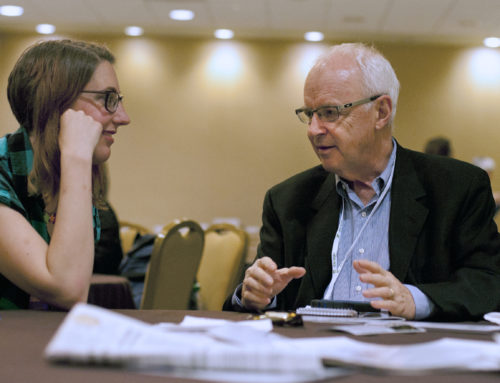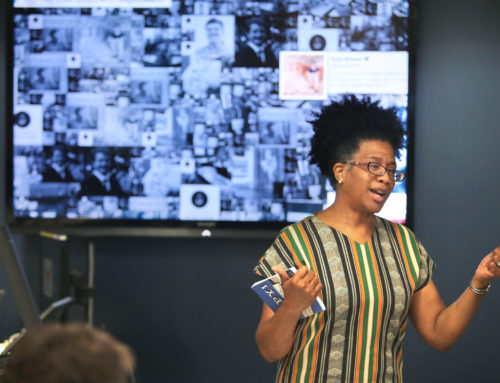
Heather Nagel, Sarah Nichols, Jeff Browne, Bradley Wilson, Mark Newton at the First Amendment Center in Nashville, Jan. 4, 2014.
At the 2014 midwinter meeting of the Scholastic Journalism Division of the Association for Education in Journalism and Mass Communication,college educators, college media advisers and leaders in scholastic journalism education sat around in the First Amendment Center at Vanderbilt University. But it wasn’t just another of those “academic” meetings with a lot of thinking and few concrete outcomes.
Sure, the 30 or so attendees, including division head Calvin Hall and vice head Jeff Browne, heard two pertinent research projects: one from Kevin Hull, a graduate student at the University of Florida, on the value of mentoring in scholastic journalism education, and one from Bruce Konkle, a faculty member at the University of South Carolina, on the expansion of journalism education as a result of the Progressive Education Movement. Sure they attendees heard from speakers such as Jim Stovall on the Interscholastic Online News Network. And panel discussions from Ken Paulson and John Seigenthaler of the First Amendment Center on the First Amendment and from Michael Martinez, Nicole Kraft, Ken Pualson and Mike Farrell on new technologies. But before discussing the future of the division, they also heard from JEA President Mark Newton, JEA Vice President Sarah Nichols, JEA Tennessee State Director Heather Nagel and me about what the division can do for scholastic advisers. The lessons discussed are worth noting for all college academics.
HELP THEM OUT
At the college level, most educators teach one type of course. I teach reporting/writing/editing. Others specialize in law/ethics. Others specialize in photojournalism. But scholastic journalism educators not only have to teach that along with fonts, InDesign, Photoshop, white space, social media and the like. They do not have the luxury to be specialists. College educators need to get out in to the classrooms and the newsrooms of scholastic educators. Not once a semester. Once a week. Volunteer to help them out on yearbook worknights. Come in a teach a lesson on photojournalism ethics. Find out what the scholastic instructor’s strengths are and volunteer to help in other areas.
This has benefits for the college or university of recruitment of quality students and should be a priority for all of us.
FIGHT THE BATTLE
Scholastic journalism educators face prior review, censorship and self-censorship every day. Whether by policy or practice, many school publications are but a shadow of what they could be. College educators need to help scholastic educators and top students fight battles when appropriate. Don’t wait for another Hazelwood case. Hazelwood is bad law. No self-respecting editor should have allowed that controversial material to be published, not because it was controversial but because it was bad journalism. We need to help train instructors and students so this poorly produced material doesn’t ever get published.
One of the most poignant topics of discussion is why fighting these battles is important. Indeed, it is important because our society depends on the Fourth Estate. A free and democratic  press is an integral part of our society. And the foundation for that free press is built at home and in our schools. We all need to own teaching how students how to consume, to utilize and to produce a quality yearbook, newspaper, blog or Tweet.
TRAIN THE ADVISERS
I support the JEA mentor program. I support financing the JEA mentor program. But I think mentoring is more than that awesome program. College educators can be, should be, regular resources to their scholastic counterparts, providing them with materials, with workshops, with campus visits, with a lunch every once in a while. Establish a relationship that benefits both programs.
RESEARCH MORE THAN CENSORSHIP
There has been a ton of research on censorship in high schools since 1988. There is as much on the role of administrators in scholastic media. But scholastic educators need research that helps them become better educators. What works? What doesn’t work? Mark Newton asked two valid questions subsequent to the AEJMC division meeting: “How do scholastic journalism educators get viable research?” and “What do we do with it once we get it?” Research needs to provide educators with more than knowledge. It needs to provide them with things they can use in the classroom. Then let’s evaluate what works and what doesn’t.
As part of a move to continue to expand the offerings of the JEA magazine, Communication: Journalism Education Today, the magazine I’ve edited for more than 15 years now will include, beginning next fall, a peer-reviewed research article as they become available. Individuals with experience in scholastic journalism education and who now have terminal degrees (doctorates) will blindly review articles to determine if they are valid for publication. If they are, we will work with the author to develop supplementary materials to accompany the article that teachers can use in the classroom. It’s a step forward. It’s a chance at a partnership.
 A TEAM
In short, educators at colleges and universities, and, quite frankly, more professionals, need to stop living in their silos. Get out in the classroom. Teach at local, state and national journalism workshops. Judge for state associations. We all stand to benefit.





Leave A Comment